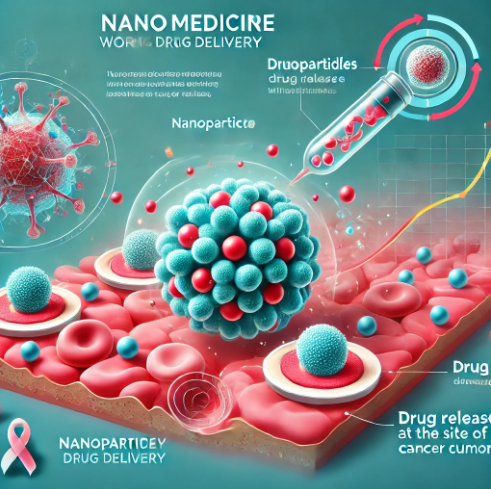Introduction
Nanomedicine is an emerging field that uses nanotechnology to improve drug delivery, diagnostics, and treatments at a molecular level. It holds the promise to revolutionize healthcare by providing more targeted therapies with fewer side effects. In this article, we will explore how nanomedicine works, its applications in modern medicine, and the future potential of this cutting-edge technology in treating various diseases.
What is Nanomedicine?
Nanomedicine involves the use of nanoparticles—tiny particles between 1 and 100 nanometers in size—in the diagnosis, monitoring, treatment, and prevention of diseases. These particles can interact with biological molecules in ways that conventional medicine cannot, allowing for more precise interventions.
Nanoparticles can be designed to deliver drugs directly to diseased cells, thereby improving the effectiveness of treatments while reducing harmful side effects. Additionally, nanomedicine is being used in imaging and diagnostics to detect diseases at an earlier stage, giving patients a better chance at recovery.
Applications of Nanomedicine
- Targeted Drug Delivery: One of the most significant advances in nanomedicine is its ability to deliver drugs directly to diseased tissues or cells. Traditional drug delivery methods often lead to drugs affecting both healthy and diseased cells, causing side effects. Nanoparticles can be engineered to attach to specific cells, such as cancer cells, and release the medication exactly where it is needed. This targeted approach is particularly useful in treating diseases like cancer, where chemotherapy can harm healthy cells as well.
- Cancer Treatment: Nanomedicine has shown promise in oncology, particularly in treating solid tumors. Nanoparticles can carry chemotherapy drugs or even radioactive particles directly to the tumor, limiting damage to surrounding healthy tissues. Moreover, nanoparticles can be engineered to increase the efficacy of immunotherapy, a treatment that boosts the body’s own immune system to fight cancer cells.
- Neurological Disorders: Delivering drugs to the brain is a significant challenge due to the blood-brain barrier, which prevents many medications from reaching the brain. Nanoparticles can be designed to cross this barrier, offering new treatment options for neurological disorders like Alzheimer’s, Parkinson’s, and multiple sclerosis.
- Infectious Diseases: Nanomedicine is also being explored in the treatment of infectious diseases, including drug-resistant bacteria. By delivering antimicrobial agents directly to infection sites, nanoparticles may help overcome the growing issue of antibiotic resistance.
- Cardiovascular Health: In cardiovascular medicine, nanoparticles are being developed to treat atherosclerosis by targeting plaques in the arteries and delivering drugs to reduce inflammation and plaque buildup. Nanoparticles may also be used in imaging to better detect blockages in arteries, improving early diagnosis of heart disease.
Benefits of Nanomedicine
- Increased Efficacy: By targeting drugs specifically to diseased cells, nanomedicine can significantly improve the efficacy of treatments.
- Reduced Side Effects: Since the drugs are delivered directly to the target cells, fewer healthy cells are affected, resulting in fewer side effects compared to traditional treatments.
- Early Diagnosis: Nanoparticles can be used in imaging to detect diseases at a much earlier stage, allowing for earlier intervention and better outcomes.
- Personalized Medicine: Nanomedicine paves the way for more personalized treatment plans. By understanding the specific biological mechanisms of each patient’s disease, nanoparticles can be customized to deliver treatments that work best for the individual.
Challenges Facing Nanomedicine
Despite its potential, nanomedicine faces several challenges:
- Regulatory Hurdles: The safety and long-term effects of nanoparticles in the body are still under investigation. Regulatory agencies are cautious in approving nanomedicine treatments due to the need for extensive clinical trials.
- Cost: Developing and manufacturing nanoparticles is currently expensive, making nanomedicine treatments more costly than traditional therapies. However, as the technology matures and becomes more widely adopted, these costs are expected to decrease.
- Limited Availability: While the technology is rapidly advancing, nanomedicine is not yet widely available in many parts of the world. Research and development are concentrated in high-income countries, limiting access for patients in low- and middle-income regions.
The Future of Nanomedicine
The future of nanomedicine looks promising. Advances in this field may soon lead to breakthroughs in treating conditions that currently have limited treatment options, such as neurodegenerative diseases and certain types of cancer. Furthermore, nanomedicine could pave the way for the development of “smart drugs” that can adapt to changes in a patient’s condition in real-time, providing more responsive and effective treatments.
The integration of artificial intelligence (AI) with nanomedicine could also lead to more precise diagnostics and treatment plans. AI can analyze large datasets from patient records and clinical trials to optimize nanoparticle design and predict patient outcomes, further advancing personalized medicine.
Conclusion
Nanomedicine is on the cusp of revolutionizing healthcare by offering more precise, targeted treatments with fewer side effects. As research continues to progress, we can expect nanotechnology to become a cornerstone of modern medicine, offering hope for better treatment outcomes in cancer, neurological disorders, cardiovascular diseases, and more. While challenges remain, the potential benefits of nanomedicine are vast, and its impact on the future of medicine is likely to be profound.
References:
- Salata, O. V. (2004). Applications of Nanoparticles in Biology and Medicine. Journal of Nanobiotechnology.
- Ferrari, M. (2005). Cancer nanotechnology: opportunities and challenges. Nature Reviews Cancer.
- Duncan, R., & Gaspar, R. (2011). Nanomedicine(s) under the microscope. Molecular Pharmaceutics.
